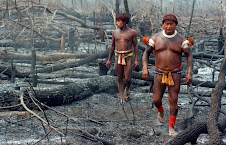Deforestation in Indonesia is a major problem that needs to be stopped but with Indonesia’s corrupt government it will take more than a few villages to convince their government that what they are doing is wrong. It all started when large scale logging of timber in Indonesia began as a follow up of establishment of the Basic Forestry Law in 1967, when all Indonesian forests were declared state property. This started the mass deforestation and also created the timber boom in the 70’s, which made Indonesia the world’s biggest raw log exporter. In the mid 80’s, government of Indonesia started to establish policies which supported the development of pulp and paper industries which also greatly increased deforestation rates and destruction of their forests. All of those events prove that Indonesia’s government could care less about their natural environment and only cares about making money. I believe the only way to stop deforestation in Indonesia is for the people to speak up and strike against the depletion of their natural rainforests and for other countries to step in too and save the last of our very few true natural rain forests.
Time line:
In 1966, 75% of Indonesia territory or 144 million hectares were still covered by forest.
In 1967, The Basic Forestry Law constituted a legal instrument facilitating commercial access to and development of income streams from legal rights to forest resources.
In 1980, government restricted log export and begun to promote plywood industry development.
In 1982, satellite aerial photos taken by Indonesia government showed that the forest coverage in Indonesia has decreased to 92.4 million hectares.
In 1982, when the oil was declined in price, the forestry sector became the second highest contributor to foreign exchange in Indonesian economy after oil and gas sector.
In 1983, five hundred and sixty private companies held the Forest Concession for 65.14 million hectares of the forest area which exceeded the total area of production allotted in the Forest Land Use Allocation.
The deforestation rate estimated from 1982 to 1993, have reached 2.4 million hectares per year.
By 1983, 560 logging concessions had been granted on 65.4 million hectares, more than the total area of Indonesia’s production forests stated in the Forest Land Use Policy.
In the end of the 90’s, Indonesia was the biggest producer in the world for plywood and managed to fulfill 75% of the world market demands.
In 1996, Indonesia exports of palm oil products have increased 32 % since the last five years, and were worth more than $ 1 billion.


No comments:
Post a Comment